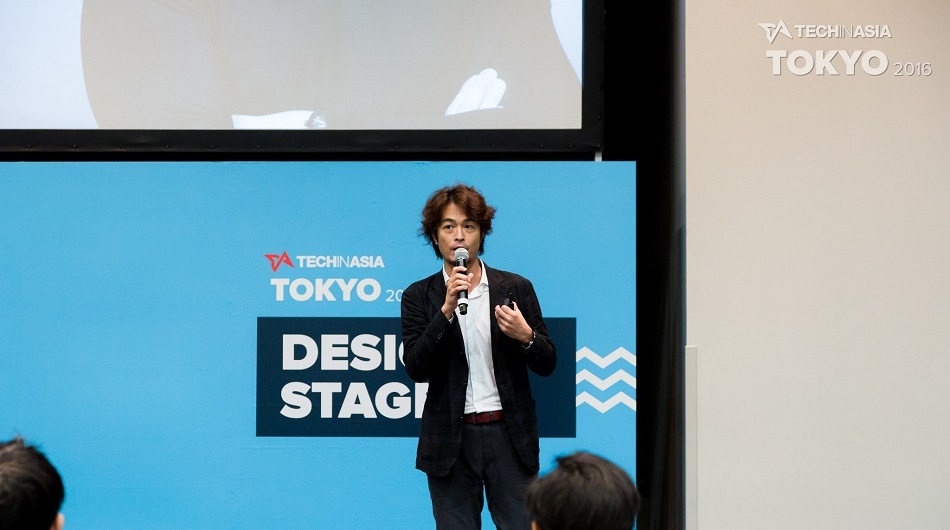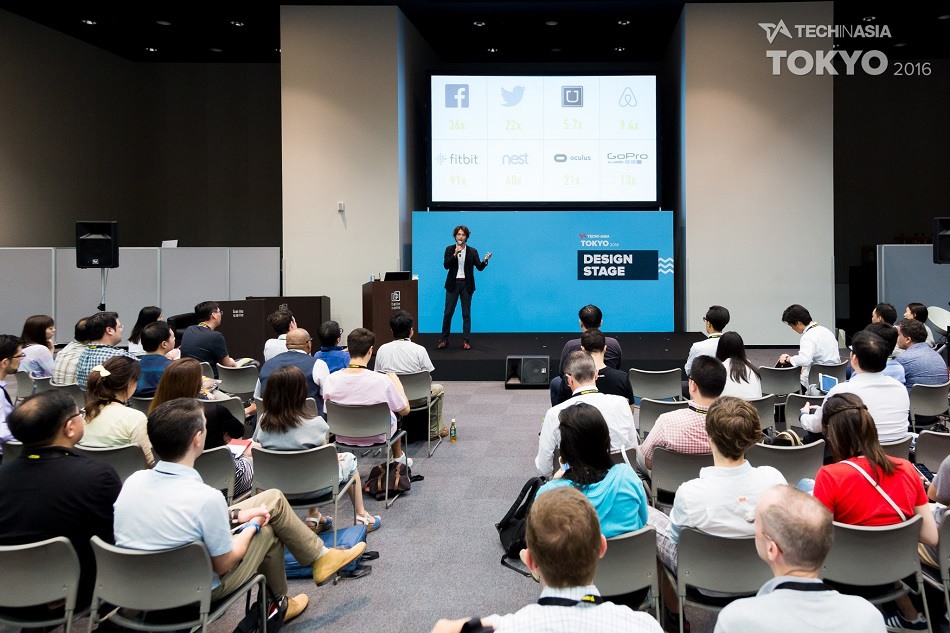
Hardware Club general partner and manufacture lead Jerry Yang on stage at Tech in Asia Tokyo 2016. Photo credit: Tech in Asia / Michael Holmes.
Backing hardware startups is a bit of a puzzle these days, so Hardware Club general partner Jerry Yang fittingly kicked off his talk at the Tech in Asia Tokyo 2016 Design Stage with a quiz.
People think that if you want to be successful as a hardware company, you have to be like Apple.
Jerry (no relation to the Yahoo co-founder; otherwise “I would be at the main stage”) showed the audience a slide displaying a revenue of US$1.9 billion for 2015 and asked everyone which company they thought it was. The answer was fitness tracker beast Fitbit.
Next up was a slide showing a market share of close to 50 percent. The answer there was GoPro in the action camera market.
Jerry said this is the kind of scale and dominance Hardware Club wants its hardware portfolio to achieve. And while the above examples’ success is a tall order, it’s actually based on some very simple factors.
“People think that if you want to be successful as a hardware company, you have to be like Apple, Samsung, Sony, or Toshiba,” Jerry said. “That’s not the case. You can generate a lot of return for your investors and for your team if you do the right thing to scale into dominance.”
Self defense
The two main questions a hardware startup has to ask themselves in the beginning, according to Jerry, are these:
- How do you scale your business?
-
How do you defend your business?
The riddle of scale for a hardware business is not much different than a software startup, Jerry said, but defending it is a bigger challenge.
Fitbit, GoPro, smart home Google acquisition Nest were recruited as examples to illustrate Jerry’s points.
First, you have to increase switching costs – otherwise known as your customers switching to a different product or brand. Nest’s Dropcam, for example, keeps customers in its ecosystem by adding a secure cloud storage component to its security camera product.
Second, a unique user interface / user experience offering is as essential to hardware as it is to software. When Nest co-founder Tony Fadell designed the company’s smart thermostat, he didn’t just add online connectivity to a regular old thermostat. He designed a user interface with the simplicity and elegance he had previously helped put into the iPod.

Jerry Yang illustrating the capital efficiency of some of the world’s most successful software and hardware startups. Photo credit: Tech in Asia / Michael Holmes.
Jerry recounted how it took the company five attempts to pass process verification before they knew their product worked as intended. That whole process ensured that Nest’s competitors and copycats would have a very hard time replicating that.
Community was a key third factor for defensibility. Jerry pointed out how Fitbit’s killer feature wasn’t its fitness tracker, which many other companies also make. Xiaomi’s Mi Band costs a fraction of a Fitbit’s asking price. But Fitbit created a social network around its product, where users can compare their performance to that of their friends and relatives wherever they are.
Fitbit emerges as one of the most successful investments in Silicon Valley.
Finally, a key defense is your brand. GoPro’s success isn’t so much because it has the sexiest action camera out there. The company made sure to build a community around the videos shot with its camera, so that a “GoPro video” became a keyword. “If you shoot a video with a Samsung [Gear 360], you can’t call it a GoPro video,” Jerry pointed out. “You can call it a Samsung video, which no one will ever Google.”
Conversely, searching for “GoPro video” immediately yields hundreds of results and drives millions of views. “The brand is the most difficult thing you can achieve, but once you do, you will have very strong defensibility,” Jerry said. “This applies not just to hardware startups, but also all the product companies in the world.”
High efficiency
Jerry attempted to trump the common mindset that hardware startups aren’t viewed as good investments by pointing out that successful hardware startups have high capital efficiency.
Capital efficiency is a company’s IPO market cap or latest valuation divided by the private funds it has raised. The higher a company’s capital efficiency multiple, the better the returns for the company and its investors.
Jerry went on to present the capital efficiency multiples for a number of software and hardware startup companies, based on their IPO market cap or most recent valuation. They looked like this:
Facebook: 36x
Twitter: 22x
Uber: 5.7x
Airbnb: 9.4x
GoPro: 13x
Oculus: 21x
Nest: 40x
Fitbit: 91x
Based on this, Fitbit emerges as one of the most successful investments in Silicon Valley. In fact, Jerry described how Fitbit was operational cash flow positive (where operational cash flow is the money generated by the company’s main business) for a while, barely touching its VC funds before going public with a market cap of US$6 billion in 2015.
Obviously all this doesn’t mean it’s easy to scale a hardware startup and make it dominant. But that is what VCs call risk, Jerry said. “What’s the special thing about risk? You can see it, you can manage it.”
This is part of the coverage of Tech in Asia Tokyo 2016, our conference taking place on September 6 and 7.
This post How GoPro, Nest, and Fitbit dominate their markets – and you can too appeared first on Tech in Asia.
from Tech in Asia https://www.techinasia.com/hardware-club-dominant-startups-tia-tokyo-2016
via IFTTT
No comments:
Post a Comment